This interactive map from eclipse2024.org will show you the exact path of totality, and show you the exact times when the partial eclipse will start and end, and how long totality will last.
Where to see it
On April 8th, the moon will pass directly between the earth and sun, casting a dark shadow along a narrow band from Mexico to Nova Scotia. Here are some helpful resources to watch this amazing darkness during the day.
If you are not inside the narrow band of totality, you will have a partial eclipse. Partial eclipses are cool, but if you can make it to the path where the moon totally blocks the sun, you will have an experience that is on another level.
At the center line, the sky will be dark for about four minutes.
What about the weather?
Texas and Mexico will probably have clear skies, but I live in western NY where a random day in April has a 70% chance of being overcast.
If you are clouded out, all is not lost. Even in the partial phases, animals will still start their evening routine. Crickets will chirp and birds will start to roost.
And a clouded out totality will still get dark for a few minutes.
Before Totality
Make a pinhole camera with a small box (coral boxes or show boxes work well. Take off the top and bottom, them put aluminum foil over one end, and a piece of white paper on the other, then use a pin to make a hole in the aluminum foil. When you aim the camera at the sun, you’ll see a small disk on the paper. Or you can use leaves in a tree, like I did in this picture.
Use a colander or a cheese grater to cast a shadow. The holes will act as dozens of tiny pinhole cameras and create multip[le image of the sun.
When the sky gets dark, the stars come out.
To the east of the sun, you will be able to see Aldebaron in Taurus and Jupiter. You might even be able to see Mercury, dancing in the sun’s corona. To the west of the sun, you’ll be able to see Venus and then Saturn and Mars. The square of Pegasus will be overhead.
But Wait! There’s a comet!
You might be able to see comet 12P/Pons-Brooks with your naked eye. Look to the left of Jupiter. It you can’t see it with the naked eye, try a pair of binoculars.
Know when it’s safe to take off your eclipse glasses and when to put them back on
Never look directly at the sun. Most of us can avoid it because it’s so bright. But even when the moon is blocking part of the sun, the sun can still damage your eyes. This eclipse timer will give you a verbal countdown for the start of totality, when you can take off you glasses, and look at the sun’s Corona—-it’s thin, outmost layer,. Even more important, it will give a countdown to the end of totality so you can have your glasses back on your face before the sun’s blinding surface pokes out from behind the moon.
During Totality
Just at the start of totality you might be able to catch the lowest layer of the sun’s atmosphere, the pink chromosphere. but you’ll only have a couple of seconds to see that before the moon blocks it. Mostly you’ll see the outermost layer of the sun’s atmosphere, its corona..
The corona is the origin of the solar wind, and a big storm on the sun’s surface makes a Coronal Mass ejection, which, if it hits earth, causes a magnetic storm and aura will be visible outside of the polar regions.
Before Totality
Shadows get weird. hold a carpenter’s square )or make an L with your fingers) about chest high and look at the shadow on the ground.. Once you find the proper orientation, one portion will have a sharp shadow and the other will be fuzzy. The closer you are to totality, the bigger the contrast will be. At the edge of the fuzzy shadow, the sunlight is only partially blocked. In the sharp shadow, the sun is either totally blocked, or not blocked at all.






